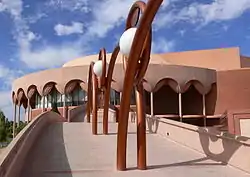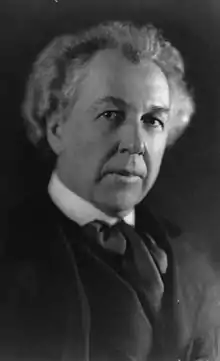Gammage Memorial Auditorium
The Grady Gammage Memorial Auditorium is a multipurpose performing arts center in Tempe, Arizona within the main campus of Arizona State University (ASU).[3] The auditorium, which bears the name of former ASU President Grady Gammage, is considered to be one of the last public commissions of American architect Frank Lloyd Wright.[4]
 Grady Gammage Memorial Auditorium | |

| |
| Address | 1200 South Forest Avenue Tempe, Arizona United States |
|---|---|
| Owner | Arizona State University |
| Capacity | 3,017[1] |
| Opened | 1964 |
| Tenants | |
| Broadway Across America | |
| Website | |
| www | |
Grady Gammage Memorial Auditorium | |
 | |
| Coordinates | 33°24′58.67″N 111°56′17.08″W |
| Architect | Frank Lloyd Wright |
| Architectural style | Usonian |
| NRHP reference No. | 85002170[2] |
| Added to NRHP | September 11, 1985 |


The Gammage stands as one of the largest exhibitors of performing arts among university venues in the world,[5][6] featuring a wide range of genres and events.
The Auditorium is listed on the National Register of Historic Places.[7]
History
The process that led to construction of the Gammage Memorial Auditorium began in 1957 when incumbent ASU President Grady Gammage desired a unique auditorium for the ASU campus.[8] In 1956, a collapsed roof rendered a campus facility that served as an auditorium and gymnasium unusable.[9][10] Gammage recruited his friend Frank Lloyd Wright to design the new auditorium. He would, with various budget related alterations, base its design on an opera house that he had conceptualized for the city of Baghdad, Iraq sometime prior upon the invitation of King Faisal II. Plans for the Baghdad opera house were abandoned after the King's assassination in the 14 July Revolution.[11] Wright is also said to be responsible for the 1200 South Forest Avenue location of the circular auditorium, a site which was then occupied by an athletic field, and earlier by G.I. housing units.[12] Wright and Gammage both died in 1959, leaving Wright's protégé William Wesley Peters to undertake completion of the auditorium. Spearheaded by the R.E. McKee Company, construction of the facility commenced in 1962 and completed twenty-five months later, officially opening on September 18, 1964, in time to host The Philadelphia Orchestra conducted by Eugene Ormandy.[13][14]
The auditorium was used for the funeral of Arizona Senator and 1964 Republican presidential nominee Barry Goldwater on June 3, 1998.[15]
On October 13, 2004, the auditorium was the site of the third and closing debate between George W. Bush and John Kerry in the 2004 U.S. Presidential Election.[16][17]
Structure
The structure measures 300 feet (91 m) long by 250 feet (76 m) wide by 80 feet (24 m) high. Fifty concrete columns support the round roof with its pattern of interlocking circles. Twin "flying buttress" pedestrian ramps extending 200 feet (61 m) from the north and east sides of the structure connect the building to the parking lot. The auditorium seats 3,017 people on its main floor, grand tier and balcony. The stage can be adapted for grand opera, Broadway musicals, dramatic productions, solo productions, organ recitals and lectures.[18][19]
Performance and other spaces
.jpg.webp)
Auditorium
The auditorium has a maximum seating capacity of 3,017. It is wheelchair accessible and has an infrared system for 100 hearing-impaired people (in addition to signers).
Stage
- Stage type: proscenium
- Playing space dimensions: 64'x33' or 64'x40'
- Proscenium opening: 64'x30'
- Height grid/ceiling: 78'
- Stage floor type: Canadian hard rock maple
- Rigging system type: 58 double purchase, 40 hydraulic (98 lines total)
Backstage
- Loading dock
- Door dimensions: 10'x11'6
- Dressing rooms: 9
- Maximum capacity: 54
Deck
Permanent installations: traps in stage, orchestra shell, hydraulic orchestra pit, electricity in pit, music stands, pianos Pit
- Dimensions: 76'x9'
- Number of stands: 85
- Chairs for pit: 90
Electrics/Sound
- Building electrics current: 9 panels-3-600/3-200/2-100/1-100 = 2700 total
- Lighting board: computer memory
- Lighting equipment: 32-8x13, 22-10x12, 55-6x9, 30 8" Fresnels, 12 Par Cans, 12 Mini Strips
See also
Bibliography
- Storrer, William Allin. The Frank Lloyd Wright Companion. University of Chicago Press, 2006, ISBN 0-226-77621-2 (S.432)
References
- "Grady Gammage Memorial Auditorium Facility Information". Arizona State University. Archived from the original on July 28, 2001.
- "National Register of Historical Places - ARIZONA - Maricopa County". National Park Service.
- "ASU Interactive Map". www.asu.edu. Retrieved Dec 13, 2020.
- "Frank Lloyd Wright's Work". Frank Lloyd Wright Foundation. Retrieved Dec 13, 2020.
- "Plan Your Visit | ASU Gammage". www.asugammage.com. Retrieved Dec 13, 2020.
- "ASU Gammage Set To Host Golden Gammage Fala" (PDF) (Press release). ASU Gammage. Archived from the original (PDF) on March 30, 2015.
- "Maps | National Park Service". www.nps.gov. Retrieved Dec 13, 2020.
- "History | ASU Gammage". www.asugammage.com. Retrieved Dec 13, 2020.
- "ASU Library:". www.asu.edu. Retrieved Dec 13, 2020.
- Lengel, Kerry. "ASU Gammage celebrates 50th anniversary". The Arizona Republic. Retrieved Dec 13, 2020.
- "CNN.com - Frank Lloyd Wright's plans for greater Baghdad - Sep. 29, 2003". www.cnn.com. Retrieved Dec 13, 2020.
- "An abridged history of Mill Avenue: The grandiose and worldly ASU Gammage". The Arizona State Press. Retrieved Dec 13, 2020.
- Goodykoontz, Bill (September 2014). "A golden Gammage". ASU Magazine. Archived from the original on October 26, 2016.
- "Frank Lloyd Wright". Retrieved Dec 13, 2020.
- "Senator Goldwater Funeral Service | C-SPAN.org". www.c-span.org. Retrieved Dec 13, 2020.
- "Thousands turn out for Bush, Kerry post-debate rallies in Phoenix, Tempe". Arizona Daily Sun. Retrieved Dec 13, 2020.
- "CPD: October 13, 2004 Debate Transcript". www.debates.org. Retrieved Dec 13, 2020.
- About ASU's Gammage Auditorium Archived May 19, 2006, at the Wayback Machine
- "ASU Gammage". Arizona Heritage Traveler. Archived from the original on May 3, 2008. Retrieved December 14, 2020.
External links
| Wikimedia Commons has media related to Gammage Auditorium. |
